Hugo J. Kuijf
for the ALFA study
Effect of latent space distribution on the segmentation of images with multiple annotations
Apr 26, 2023Abstract:We propose the Generalized Probabilistic U-Net, which extends the Probabilistic U-Net by allowing more general forms of the Gaussian distribution as the latent space distribution that can better approximate the uncertainty in the reference segmentations. We study the effect the choice of latent space distribution has on capturing the variation in the reference segmentations for lung tumors and white matter hyperintensities in the brain. We show that the choice of distribution affects the sample diversity of the predictions and their overlap with respect to the reference segmentations. We have made our implementation available at https://github.com/ishaanb92/GeneralizedProbabilisticUNet
* Accepted for publication at the Journal of Machine Learning for Biomedical Imaging (MELBA) https://melba-journal.org/2023:005. arXiv admin note: text overlap with arXiv:2207.12872
Where is VALDO? VAscular Lesions Detection and segmentatiOn challenge at MICCAI 2021
Aug 15, 2022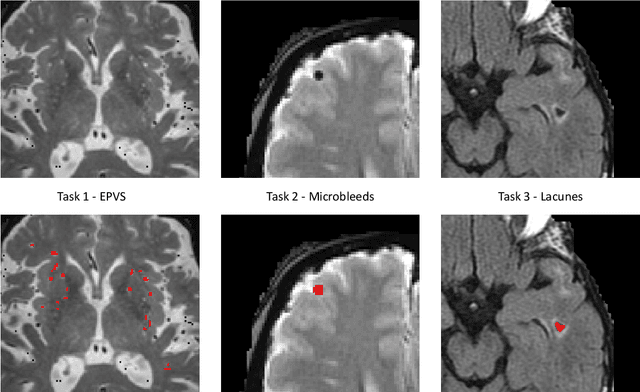
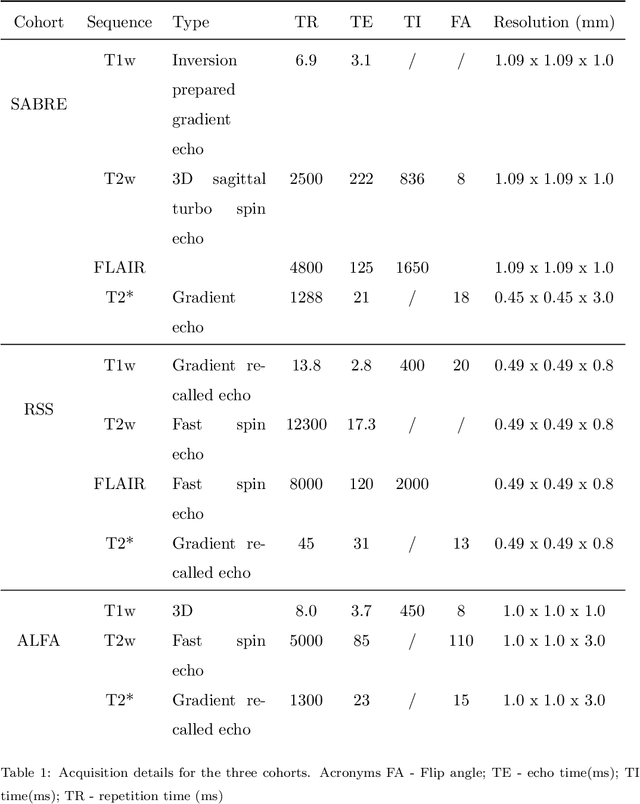

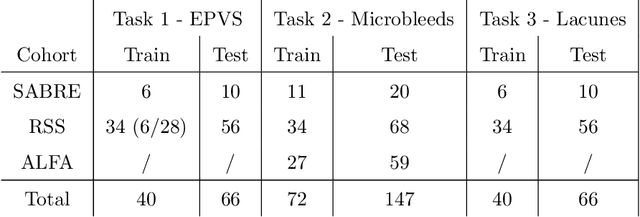
Abstract:Imaging markers of cerebral small vessel disease provide valuable information on brain health, but their manual assessment is time-consuming and hampered by substantial intra- and interrater variability. Automated rating may benefit biomedical research, as well as clinical assessment, but diagnostic reliability of existing algorithms is unknown. Here, we present the results of the \textit{VAscular Lesions DetectiOn and Segmentation} (\textit{Where is VALDO?}) challenge that was run as a satellite event at the international conference on Medical Image Computing and Computer Aided Intervention (MICCAI) 2021. This challenge aimed to promote the development of methods for automated detection and segmentation of small and sparse imaging markers of cerebral small vessel disease, namely enlarged perivascular spaces (EPVS) (Task 1), cerebral microbleeds (Task 2) and lacunes of presumed vascular origin (Task 3) while leveraging weak and noisy labels. Overall, 12 teams participated in the challenge proposing solutions for one or more tasks (4 for Task 1 - EPVS, 9 for Task 2 - Microbleeds and 6 for Task 3 - Lacunes). Multi-cohort data was used in both training and evaluation. Results showed a large variability in performance both across teams and across tasks, with promising results notably for Task 1 - EPVS and Task 2 - Microbleeds and not practically useful results yet for Task 3 - Lacunes. It also highlighted the performance inconsistency across cases that may deter use at an individual level, while still proving useful at a population level.
Future Unruptured Intracranial Aneurysm Growth Prediction using Mesh Convolutional Neural Networks
Aug 01, 2022


Abstract:The growth of unruptured intracranial aneurysms (UIAs) is a predictor of rupture. Therefore, for further imaging surveillance and treatment planning, it is important to be able to predict if an UIA is likely to grow based on an initial baseline Time-of-Flight MRA (TOF-MRA). It is known that the size and shape of UIAs are predictors of aneurysm growth and/or rupture. We perform a feasibility study of using a mesh convolutional neural network for future UIA growth prediction from baseline TOF-MRAs. We include 151 TOF-MRAs, with 169 UIAs where 49 UIAs were classified as growing and 120 as stable, based on the clinical definition of growth (>1 mm increase in size in follow-up scan). UIAs were segmented from TOF-MRAs and meshes were automatically generated. We investigate the input of both UIA mesh only and region-of-interest (ROI) meshes including UIA and surrounding parent vessels. We develop a classification model to predict UIAs that will grow or remain stable. The model consisted of a mesh convolutional neural network including additional novel input edge features of shape index and curvedness which describe the surface topology. It was investigated if input edge mid-point co-ordinates influenced the model performance. The model with highest AUC (63.8%) for growth prediction was using UIA meshes with input edge mid-point co-ordinate features (average F1 score = 62.3%, accuracy = 66.9%, sensitivity = 57.3%, specificity = 70.8%). We present a future UIA growth prediction model based on a mesh convolutional neural network with promising results.
Generalized Probabilistic U-Net for medical image segementation
Jul 26, 2022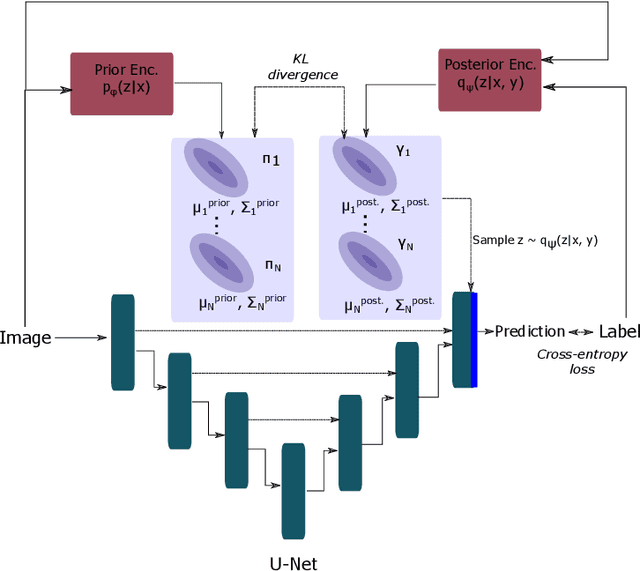

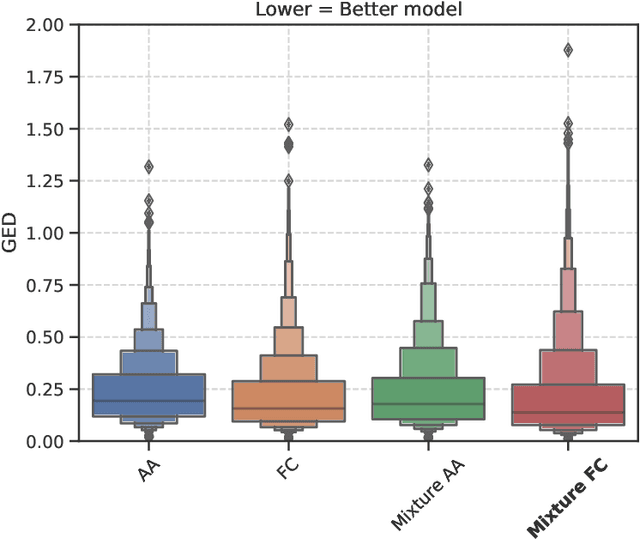
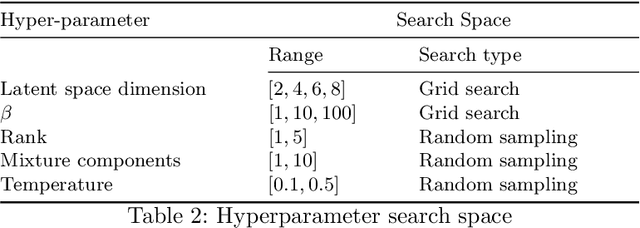
Abstract:We propose the Generalized Probabilistic U-Net, which extends the Probabilistic U-Net by allowing more general forms of the Gaussian distribution as the latent space distribution that can better approximate the uncertainty in the reference segmentations. We study the effect the choice of latent space distribution has on capturing the uncertainty in the reference segmentations using the LIDC-IDRI dataset. We show that the choice of distribution affects the sample diversity of the predictions and their overlap with respect to the reference segmentations. For the LIDC-IDRI dataset, we show that using a mixture of Gaussians results in a statistically significant improvement in the generalized energy distance (GED) metric with respect to the standard Probabilistic U-Net. We have made our implementation available at https://github.com/ishaanb92/GeneralizedProbabilisticUNet
Influence of uncertainty estimation techniques on false-positive reduction in liver lesion detection
Jun 22, 2022
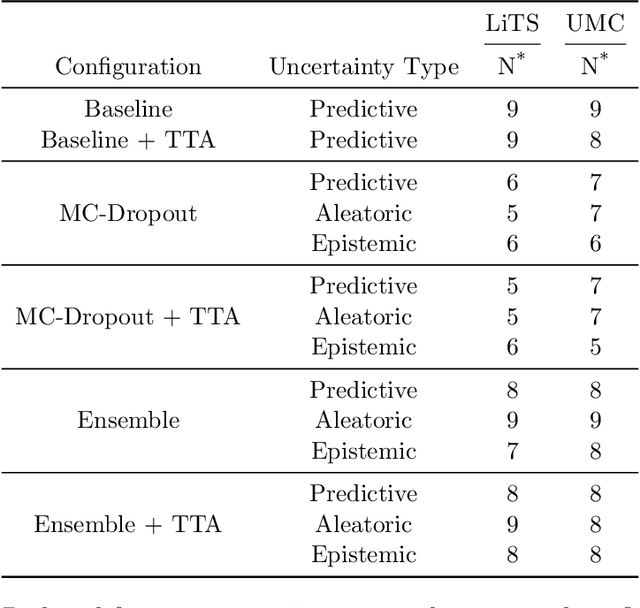
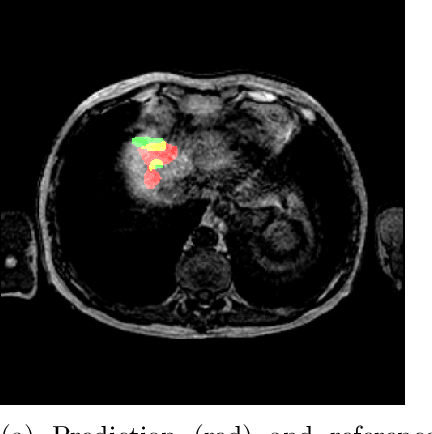

Abstract:Deep learning techniques show success in detecting objects in medical images, but still suffer from false-positive predictions that may hinder accurate diagnosis. The estimated uncertainty of the neural network output has been used to flag incorrect predictions. We study the role played by features computed from neural network uncertainty estimates and shape-based features computed from binary predictions in reducing false positives in liver lesion detection by developing a classification-based post-processing step for different uncertainty estimation methods. We demonstrate an improvement in the lesion detection performance of the neural network (with respect to F1-score) for all uncertainty estimation methods on two datasets, comprising abdominal MR and CT images respectively. We show that features computed from neural network uncertainty estimates tend not to contribute much toward reducing false positives. Our results show that factors like class imbalance (true over false positive ratio) and shape-based features extracted from uncertainty maps play an important role in distinguishing false positive from true positive predictions
Progressive GANomaly: Anomaly detection with progressively growing GANs
Jun 08, 2022Abstract:In medical imaging, obtaining large amounts of labeled data is often a hurdle, because annotations and pathologies are scarce. Anomaly detection is a method that is capable of detecting unseen abnormal data while only being trained on normal (unannotated) data. Several algorithms based on generative adversarial networks (GANs) exist to perform this task, yet certain limitations are in place because of the instability of GANs. This paper proposes a new method by combining an existing method, GANomaly, with progressively growing GANs. The latter is known to be more stable, considering its ability to generate high-resolution images. The method is tested using Fashion MNIST, Medical Out-of-Distribution Analysis Challenge (MOOD), and in-house brain MRI; using patches of sizes 16x16 and 32x32. Progressive GANomaly outperforms a one-class SVM or regular GANomaly on Fashion MNIST. Artificial anomalies are created in MOOD images with varying intensities and diameters. Progressive GANomaly detected the most anomalies with varying intensity and size. Additionally, the intermittent reconstructions are proven to be better from progressive GANomaly. On the in-house brain MRI dataset, regular GANomaly outperformed the other methods.
MixLacune: Segmentation of lacunes of presumed vascular origin
Aug 05, 2021



Abstract:Lacunes of presumed vascular origin are fluid-filled cavities of between 3 - 15 mm in diameter, visible on T1 and FLAIR brain MRI. Quantification of lacunes relies on manual annotation or semi-automatic / interactive approaches; and almost no automatic methods exist for this task. In this work, we present a two-stage approach to segment lacunes of presumed vascular origin: (1) detection with Mask R-CNN followed by (2) segmentation with a U-Net CNN. Data originates from Task 3 of the "Where is VALDO?" challenge and consists of 40 training subjects. We report the mean DICE on the training set of 0.83 and on the validation set of 0.84. Source code is available at: https://github.com/hjkuijf/MixLacune . The docker container hjkuijf/mixlacune can be pulled from https://hub.docker.com/r/hjkuijf/mixlacune .
MixMicrobleed: Multi-stage detection and segmentation of cerebral microbleeds
Aug 05, 2021



Abstract:Cerebral microbleeds are small, dark, round lesions that can be visualised on T2*-weighted MRI or other sequences sensitive to susceptibility effects. In this work, we propose a multi-stage approach to both microbleed detection and segmentation. First, possible microbleed locations are detected with a Mask R-CNN technique. Second, at each possible microbleed location, a simple U-Net performs the final segmentation. This work used the 72 subjects as training data provided by the "Where is VALDO?" challenge of MICCAI 2021.
MixMicrobleedNet: segmentation of cerebral microbleeds using nnU-Net
Aug 03, 2021

Abstract:Cerebral microbleeds are small hypointense lesions visible on magnetic resonance imaging (MRI) with gradient echo, T2*, or susceptibility weighted (SWI) imaging. Assessment of cerebral microbleeds is mostly performed by visual inspection. The past decade has seen the rise of semi-automatic tools to assist with rating and more recently fully automatic tools for microbleed detection. In this work, we explore the use of nnU-Net as a fully automated tool for microbleed segmentation. Data was provided by the ``Where is VALDO?'' challenge of MICCAI 2021. The final method consists of nnU-Net in the ``3D full resolution U-Net'' configuration trained on all data (fold = `all'). No post-processing options of nnU-Net were used. Self-evaluation on the training data showed an estimated Dice of 0.80, false discovery rate of 0.16, and false negative rate of 0.15. Final evaluation on the test set of the VALDO challenge is pending. Visual inspection of the results showed that most of the reported false positives could be an actual microbleed that might have been missed during visual rating. Source code is available at: https://github.com/hjkuijf/MixMicrobleedNet . The docker container hjkuijf/mixmicrobleednet can be pulled from https://hub.docker.com/r/hjkuijf/mixmicrobleednet .
Explainable artificial intelligence (XAI) in deep learning-based medical image analysis
Jul 22, 2021



Abstract:With an increase in deep learning-based methods, the call for explainability of such methods grows, especially in high-stakes decision making areas such as medical image analysis. This survey presents an overview of eXplainable Artificial Intelligence (XAI) used in deep learning-based medical image analysis. A framework of XAI criteria is introduced to classify deep learning-based medical image analysis methods. Papers on XAI techniques in medical image analysis are then surveyed and categorized according to the framework and according to anatomical location. The paper concludes with an outlook of future opportunities for XAI in medical image analysis.
 Add to Chrome
Add to Chrome Add to Firefox
Add to Firefox Add to Edge
Add to Edge